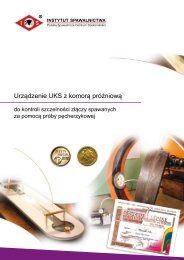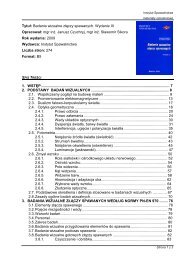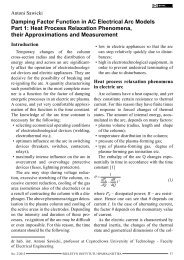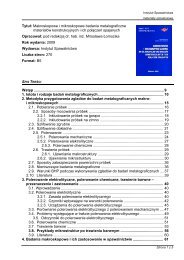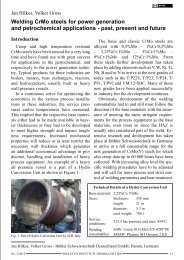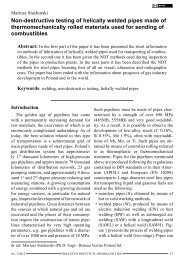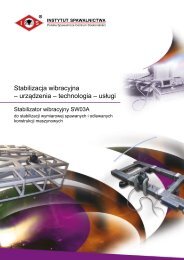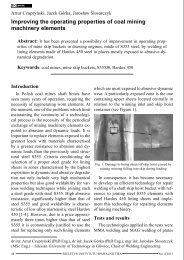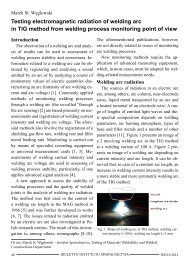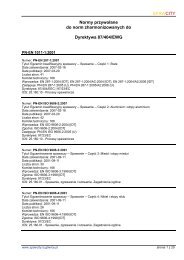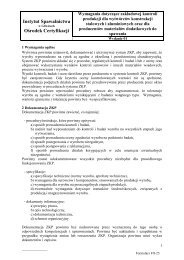Biuletyn Instytutu Spawalnictwa No. 01/2012
Biuletyn Instytutu Spawalnictwa No. 01/2012
Biuletyn Instytutu Spawalnictwa No. 01/2012
Create successful ePaper yourself
Turn your PDF publications into a flip-book with our unique Google optimized e-Paper software.
tion of a function connected with the matrix<br />
of a detector and functions related to optical<br />
elements of a spectrometer system [8]. Factors<br />
causing the extension of spectral lines can be<br />
divided into those producing<br />
the Lorentz and<br />
Gaussian shapes of line<br />
profiles. Their impact on<br />
the value of extension varies<br />
and may depend on<br />
conditions present in plasma.<br />
A spectral line resultant<br />
profile is a function<br />
being the combination of<br />
the Lorentz and Gaussian<br />
[50] functions called the<br />
Voigt profile [8, 52].<br />
It should be noted that a photoelectric detector<br />
is reached both by useful signals and<br />
background radiation. As a result, at the CCD<br />
detector output there are useful signals accompanied<br />
by noise originating from the background.<br />
In order to eliminate the impact of background<br />
radiation, one should deduct it while<br />
analysing the distribution of welding arc radiation<br />
intensity.<br />
Due to the resolution of converters one should<br />
take into consideration the fact that registered<br />
files are a “cluster” of several spectral<br />
lines of a given element (Fig. 6) or even of a<br />
few elements of various levels of ionisation.<br />
Therefore, the matching of a shape function<br />
matters only for the determination of the gravity<br />
centre for such a group of files. The first<br />
element of a system for monitoring welding<br />
processes is the development of a method for<br />
identification and measurement of quantities<br />
characterising registered spectral peaks such<br />
as the peak width, the location of maximum<br />
and amplitude. The investigation into which<br />
function better describes the profile of a peak<br />
(“cluster” of spectral lines) seems to be decisive<br />
for the detection of welding process disturbance.<br />
Peak profiles can be the Gaussian,<br />
Lorentz and Voigt functions (Fig. 6).<br />
Fig. 6. Exemplary peak matched with Gaussian, Lorentz<br />
and Voigt functions, I=200 A, L=3 mm, 100 % Ar with<br />
marked selected spectral lines<br />
The matching with functions is usually<br />
carried out using the least squares method<br />
(e.g. the Levenberg-Marquardt algorithm).<br />
One can also adapt specialist software for<br />
this activity. On the basis of matched parameters<br />
of a function one can calculate the location<br />
of the spectral line maximum (x c<br />
) and<br />
the width of a spectral line (FWHM). During<br />
the development of experimental data, one<br />
should also take into account the so-called<br />
additive constant y 00<br />
, the presence of which<br />
results from additional signals registered by<br />
measuring equipment.<br />
Next, on the basis of equation (7) one can<br />
determine the dependence binding the intensity<br />
of welding arc radiation (energy radiated<br />
for a given spectral line x c<br />
) B iv<br />
, arc length<br />
and welding current intensity. Using a computer<br />
programme, one can use collected data<br />
to calculate the coefficients G i<br />
and γ.<br />
NR <strong>01</strong>/2<strong>01</strong>2<br />
BIULETYN INSTYTUTU SPAWALNICTWA<br />
47



